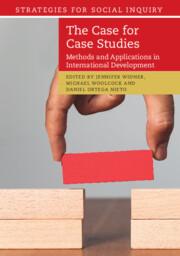Appendix 2.2
A SCEM is a set of equations in block triangular form:Footnote 19
SCEMs provide a concise representation of what causal sequences are possible in a specific case given the facts about that case – that is, what values the quantities represented can take in relation to values of their causes and effects. Each equation is itself a potential outcomes equation (POE). The variables are time ordered so that for xj<k, xj occurs simultaneous with, or earlier than, xk. As with a single POE, variables on the left represent effects, one of which will be the targeted outcome; c= signifies that the two sides of the equation are equal and that the factors on the right are causes of those on the left.
Warning. In addition to the warning in Section 2.5, I offer some further, more technical cautions here. The linear simultaneous equations forms that appear in a SCEM are also familiar within social science, for example from the work of Herbert Reference SimonSimon (1957) on causality, in path analysis, in econometrics, as the basis for Judea Pearl’s causal Bayesian networks,Footnote 20 etc. I say ‘warning’ because I see two related problems cropping up. First, the equations show relations between quantities but they do not express which populations of individual cases these relations hold for, and often this is not made clear in social science uses. I use these equations for identified individual cases. Second, generally some of the variables are labelled ‘exogenous’ (determined outside the system of equations, indicated by the µ in the first equation) and a joint probability is supposed for them. This supposes some population of individual cases to which this probability applies, but again, which population that is – or why we should suppose there is a probability to be had for those variables in that population – is usually not specified.



